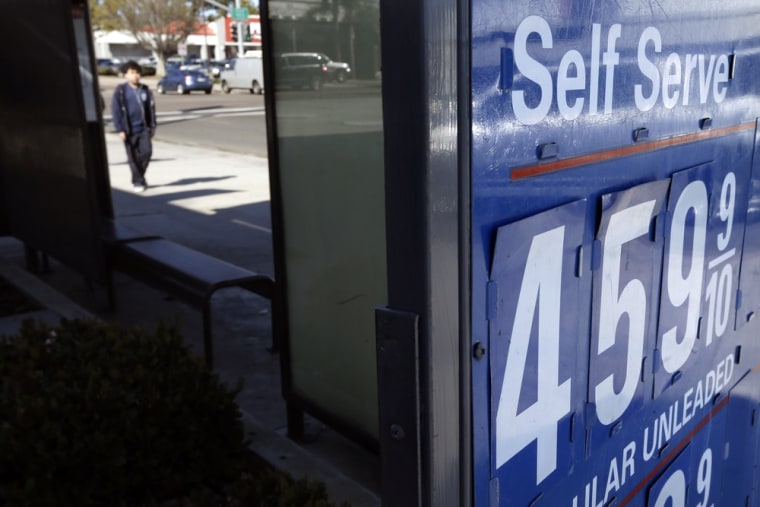The recent run-up in gasoline prices has some economists – including Federal Reserve Chairman Ben Bernanke – worried about the impact on consumer spending and the economy.
It’s a perennial concern. When gas prices spike, as they have done in the past few weeks, the extra money you pay at the pump forces you to cut spending on other things. That takes a bite out of overall consumer spending, which fuels roughly 70 percent of the U.S. economy. Slower spending means slower growth.
But the longer-term impact is not as great as some forecasters would have you believe. Here’s why:
Why is Chairman Bernanke soworried?
He’s concerned mostly because the economy isn’t growing as fast as it should be this far into an economic recovery. For reasons that most economists believe are temporary, the U.S. gross domestic product ground to a screeching halt in the last three months of last year. Bernanke and his Fed policy colleagues have been doing everything they can to get the economy moving ahead. But unemployment remains stubbornly high and near-zero interest rates don’t seem to be working.
In his Congressional testimony Tuesday on the state of the economy, Bernanke worried out loud that one reason for the slow growth is that higher gasoline prices “are hitting family budgets.”
So how hard do budgets get hit by higher gas prices?
In the short term, gas price spikes can have an bigger impact than they should, largely because gasoline is one of the few commodity prices consumers track so closely. (Quick: how much does a loaf of bread cost at your local grocery store?)
An opinion poll conducted last week by the National Association of Convenience Stores found that 44 percent of consumers said that gas prices have a "great impact" in how they feel about the economy, up from the 38 percent who felt that way in January.
See? Bernanke’s right.
In the short-run, yes, a gas price spike can slow the economy – a little. But over the long run, the impact is not all that great. To see why, we’re going to have to do a little math.
American drivers burn through about 350 million gallons of gasoline a day this time of year, at a cost of a little over $400 billion a year. Pump prices bottomed in December (as they usually do every year) at $3.32 a gallon and then shot up by 53 cents to an average of $3.85 a gallon nationwide, according to the latest Department of Energy figures. (We're using the data for all formulas, all grades.) This year, that seasonal rise has come earlier, and quicker, than usual.
If that increase held through the rest of the year, the hit to spending would be about a half percent of GDP. With an economy that’s only growing about 2 percent a year, that’s a fairly big number.
But that math doesn’t account of the savings consumers enjoy when gas prices fall. For the past three years, prices have bounced in a range between about $2.75 and $4.00 a gallon. The three-year average has been $3.43 a gallon. If you use that price as a starting point, the recent increase – even if sustained for a full year – would only knock about two-tenths of a percent from GDP.
Those numbers don’t look right. I’m paying a lot more than that at the pump, and it’s taking a big bite out of my paycheck.
Again, these are averages. For some people, the impact is much more severe. California drivers are paying $4.20 a gallon on average. If you live 30 miles from the nearest grocery store, you’re going to feel the impact of every extra penny a lot more than someone who commutes to work by subway.
Lower-income households feel the impact much more than those further up the income ladder. On average, roughly 5.5 percent of American household budgets go to pay for gasoline. But gasoline bills eat up a bigger portion of the weekly budget for those in the bottom quintile that for those at the top.
But gas prices hurt more than other price increases because I can’t cut back on driving.I have to get to work. What am I supposed to do?
You’re right. For most Americans, especially outside of major cities, gas price spikes are extremely painful because it’s very difficult to cut back in the short run. But over time, drivers can – and do – respond.
The long-term rise in gasoline prices over the past decade – and the pain of sudden spikes – is one of the biggest reasons that the consumption of gasoline has been falling since August 2007. Americans have been burning through about four percent less gasoline every year since then - even as the number of cars and trucks on the road continues to increase. Thanks to improvements in engine technology, higher-mileage government mandates and strong consumer demand for fuel-efficient cars and trucks, that trend is expected to continue.
Demand for those higher-mileage vehicles has, in turn, spurred a surge in consumer spending on new cars, a category has been an important source of strength for the U.S. recovery. That improvement in the overall mileage of the U.S. fleet has, in turn, helped offset the impact of gas price spikes.
Since bottoming in the first quarter of 2010, new car sales have zoomed ahead – up nearly 60 percent to $103 billion in the final three months of 2012. About two-thirds of that money went to domestic car makers. Light truck sales have jumped 40 percent, to more than $140 billion for the latest quarter.
The boom in sales is coming partly because drivers deferred buying during the recession. But they’re also snapping up new models with better gas mileage that will continue to reduce consumption – and blunt the economic impact of future gas price spikes.
